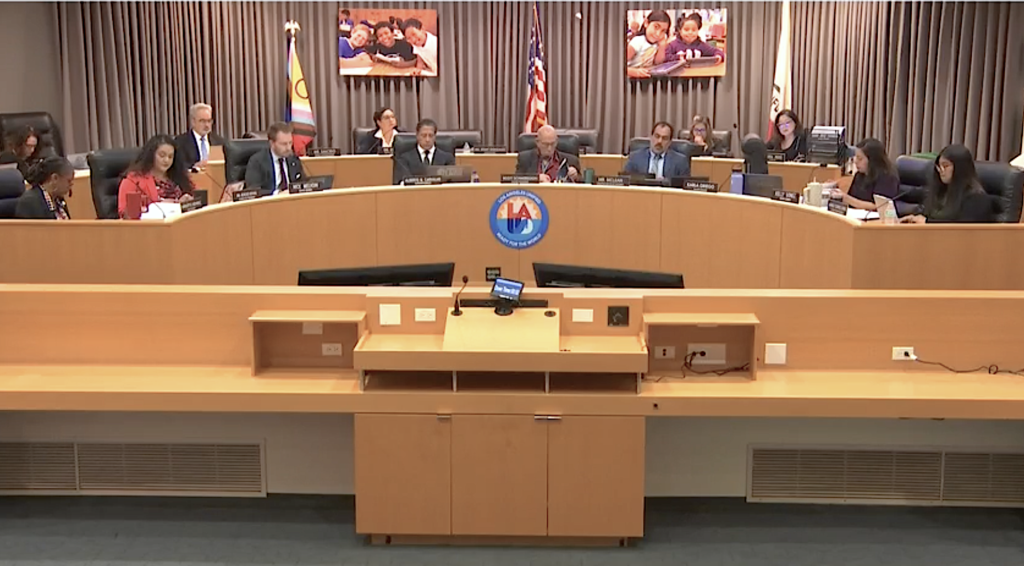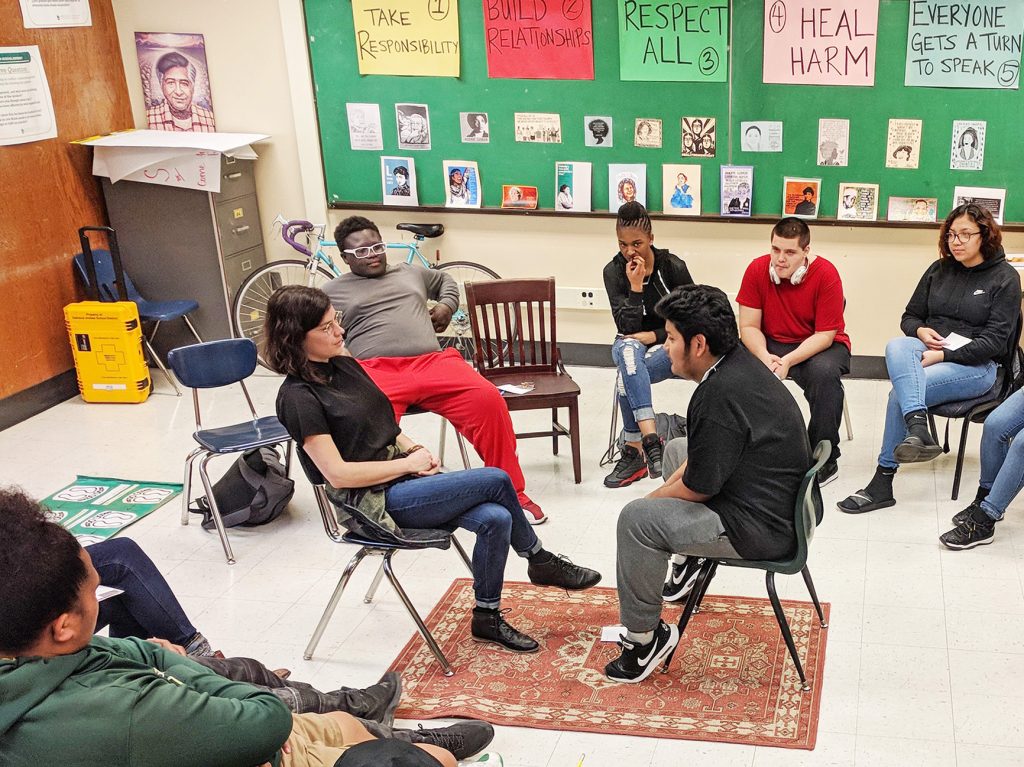
Gov. Gavin Newsom discusses his proposed state budget for the 2024-2025 fiscal year, during a news conference in Sacramento on Jan. 10, 2024.
Credit: Office of the Governor
Gov. Gavin Newsom would protect schools and community colleges from the brunt of an $11.3 billion projected drop in state revenue for education, under a proposed 2024-25 state budget he released on Wednesday. The budget calls for covering all current levels of funding and existing commitments for new and expanded programs, plus a less than 1% cost-of-living increase for next year.
The three-year decline in revenue, both for schools and the overall $38.7 billion in the state general fund, is $30 billion less than the Legislative Analyst’s Office had projected a month ago, easing the burden of balancing the budget and avoiding the possibility of drastic budget cuts or late payments — at least for community colleges and TK-12.
However, Newsom is proposing to defer the promised 5% increases in revenue to both the University of California and California State University systems. UC and CSU would borrow that funding this year and get reimbursed in next year’s budget.
“We are deferring but not delaying, and there’s a distinction in the law that will allow UC and CSU just for one year to be able to borrow against that commitment,” Newsom said.
Newsom would protect schools and community colleges by withdrawing about $7 billion from the $10.8 billion TK-14 rainy day fund to cover the current year’s shortfall and meet the minimum obligation in 2024-25. The state would not seek reimbursement for what turned out to be funding above the minimum Proposition 98 statutory obligation for the prior two years.
Proposition 98 is the funding formula determining the portion of the state’s general fund that must be spent on TK-12 and community colleges. With the addition of transitional kindergarten, that share will rise about one percentage point to 39.5% of the general fund. In 2024-25, Proposition 98 funds will be $109.1 billion. That would be about $3.5 billion more than the revised projection for 2023-24, reflecting expectations of improved state revenues in the next fiscal year.
The Legislature was handicapped when it passed the 2023-24 budget last June. There were indications but no hard numbers that economic conditions were worsening, because the deadline for paying state and federal income taxes had been extended from April 15 to Oct. 16 in response to massive flooding last winter. As it turned out, state revenues had fallen sharply from slower home sales, a drop in new startups in Silicon Valley, and declining income of the top 1% of earners, who contribute 50% of the personal income tax receipts.
But with the stock market rebounding since then, Newsom said more optimistic revenue projections for next year and savings in state government operations would account for two-thirds of the difference between the state Department of Finance revenue projections and the legislative analyst’s forecast. A remedy for dealing with a two-year, $10-plus billion drop in Proposition 98 funding would account for the rest of the disparity. In a news conference, Newsom chided the “ready, fire, aim” projections of the news media and others for assuming a more dire financial outlook without the latest data.
Many districts, nonetheless, will face financial stress. More than two-thirds are facing declining enrollment, which will lower their share of state funding. And the 1% inflation adjustment for 2024-25 will not cover cost increases and, for some districts, negotiated staff raises. Districts are receiving an 8% cost-of-living adjustment this year, down from a 13% bump in 2022-23.
Newsom’s January budget will now undergo six months of negotiations with the Legislature over their priorities. Revenue updates by June will reveal whether his optimism will hold up, and what the Legislature must do if it doesn’t.
Newsom reiterated that the state would uphold its education commitments to schools using record post-Covid revenues. These include the addition of transitional kindergarten and appropriating $8 billion combined to create community schools and add summer programs and after-school hours for low-income students. These would continue to be funded at promised levels.
Also surviving is an additional $300 million for the state’s poorest schools. The governor said that this proposal, known as an “equity multiplier,” is also a high priority by the California Legislative Black Caucus. Another priority that Newsom mentioned is funding for the UCLA Ralph J. Bunche Center for African American Studies.
“In the face of a large deficit, it’s reassuring that the governor committed to maintaining his transformative investments in education, including community schools, universal TK, and the equity multiplier,” said John Affeldt, managing attorney for the student advocacy nonprofit Public Advocates. “That the governor particularly called them out with a ‘don’t touch’ message to the Legislature indicates he’ll fight hard to maintain them.”
New ideas for mitigating student absences
Despite $6 billion in one-time state funding for post-pandemic learning recovery, chronic absences soared to 30% in 2022-23 and remained high last year. Statewide post-pandemic test scores also plummeted in math and English language arts in 2022-23 statewide and almost remained flat last year.
Recognizing that students can’t learn when they aren’t in school, Newsom is proposing changes in the law that will allow school districts to provide attendance recovery programs in response to chronic absences and loss in learning because of floods, wildfires and other climate conditions. Districts, in turn, would benefit from offsetting revenues lost from student absences. The new law would specify that districts could fund Saturday programs and intercessions to respond to students with many absences.
Districts would be required to offer students access to remote instruction, including enabling families to enroll in neighboring districts “for emergencies” lasting five or more days. A budget trailer bill will spell out details, including whether students could seek tutoring under this option.
The budget calls for $6 million to research hybrid and remote learning and develop new models.
“We have to use the experiences of recent years to think forward for ensuring that kids can gain access to the learning and instructional opportunities that they deserve,” said Hedy Chang, founder and executive director of Attendance Works, a group that tracks chronic absenteeism.
Addressing a teacher shortage
Newsom also proposes to relax some requirements to become a teacher, due to a persistent teacher shortage. Teacher candidates will no longer have to take a test or coursework to prove they have the basic skills to earn a credential, according to the state summary of the budget. The state will now recognize completion of a bachelor’s degree as satisfying the basic-skills requirement.
Currently, teacher candidates must pass the California Basic Educational Skills Test, a combination of other tests, or complete specific coursework to prove they have the basic skills to teach. The CBEST tests reading, math and writing skills and is usually taken before a student is accepted into a teacher preparation program.
The governor’s budget calls for streamlining the process of credentialing aspiring arts teachers in response to the passage of Proposition 28, the groundbreaking arts education initiative. It directs the Commission on Teacher Credentialing to create a new Elementary Arts and Music Education authorization for career technical education teachers. This pathway currently only exists for secondary education, and many arts education advocates have pressed to expand it to elementary school classrooms.
“Governor Newsom’s proposal is an important step in the right direction,” said Austin Beutner, the former superintendent of Los Angeles Unified School District, who authored Proposition 28. “The money from Prop 28 is the enabler, but students will only benefit when schools use it to hire great arts teachers in all grade levels.”
The budget summary also refers to several other proposals that will make it easier to become a teacher, although it offered no additional details about those proposals.
The budget proposal also includes:
- $20 million as the first step toward implementing the long-debated math framework that the State Board of Education adopted last July. A county office of education would be chosen to work with math experts and nonprofits to train math coaches and leaders, who in turn would teach high-quality instruction. State law would spell out that existing state learning loss funding should focus on teacher training in math.
- $5 million to increase support for the California Cradle-to-Career Data System.
- $122 million to increase funding for universal school meals.
The budget contains good and bad news for districts seeking immediate funding for facilities. Newsom would reduce the General Fund by delaying $550 million for new and retrofitted facilities for adding transitional kindergarten. And he proposes to cut $500 million he committed to the state School Facilities Program, which has run out of state funding. However, Newsom committed to negotiate a multibillion-dollar school facilities bond with the Legislature for the November 2024 ballot.
Questions on the size of the bond needed to win voter support and whether it should include higher education must be answered, Newsom said. “All that’s being worked on, but a real issue to address is that we’ve exhausted the previous bond, and it’s important to advance a new one.”
Higher education
In 2022, Newsom made agreements with both UC and CSU to give annual 5% base funding increases over five years in exchange for increasing enrollment and improving graduation rates.
Under his latest proposal, UC and CSU would borrow a combined $499 million this year — $258.8 million for UC and $240.2 million for CSU. That includes this year’s 5% increase for the systems as well as $31 million for UC to increase enrollment of resident undergraduate students.
If lawmakers agree to Newsom’s plan, the two systems would receive two years’ worth of 5% budget increases in next year’s state budget to make up for this year’s deferrals.
“These decisions will position our state and its students for a prosperous future once budgetary challenges subside,” Michael Drake, UC’s systemwide president, said in a statement Wednesday. “During economic downturns, the University of California’s role in California’s economic development is even more important, and we are grateful to state leaders for their visionary leadership and commitment to maintaining the funding compact.”
Cal State Chancellor Mildred Garcia said that given the state’s financial challenges, the governor’s plan acknowledges his financial commitment to CSU students while also attempting to address the state’s budget situation. But the proposal also puts the system in a precarious position.
“This proposal would deliver the same level of funding per fiscal year as originally outlined in the compact, although with additional risk to the CSU if the state’s budget condition further erodes and the state cannot fulfill this restructured commitment,” Garcia said. “We will explore our funding options to advance compact-related goals during the one-year delay and will proceed with financial prudence as we review the impacts and implications of this budget proposal.”
Newsom’s spending plan would not fund a significant expansion of the Cal Grant, the state’s main financial aid program. He and lawmakers agreed in 2022 to overhaul the Cal Grant beginning in 2024-25 by simplifying the awards and extending eligibility to more students, but only if state revenues were sufficient to do so. With the state facing a shortfall, the governor is not committing funding to that expansion, though negotiations on the issue are expected to continue through the spring. A spokesperson for Newsom’s Department of Finance said Wednesday that the department will wait until May to make a final determination.
Newsom also proposed doing away with a program that would provide interest-free loans to colleges and universities to build affordable student housing. In total, that would save $494 million for the state’s 2024-25 budget: $194 million that was appropriated last year plus $300 million this and every year through 2028-29.
Mike Fong, chair of the Assembly’s higher education committee, said in a statement that he’s disappointed that Newsom proposed eliminating the Student Housing Revolving Loan Fund and didn’t include funding to reform the Cal Grant.
“We must continue to find new ways to increase accessibility to higher education, especially for our most vulnerable communities who need these vital resources to complete higher education,” Fong said.
Early education
The budget largely holds steady for early education and child care. It maintains ongoing funding for the newly expanded transitional kindergarten program for 4-year-olds and earmarks $1.7 billion toward long-awaited increased pay for child care providers. It also continues to gradually add subsidized child care slots, with about $2 billion going to fund about 146,000 new slots to be filled by 2024-25, toward an ultimate goal of 200,000 new slots.
“Overall, the proposed budget stays true to the historic investments California has made in pre-K and child care,” said Scott Moore, head of Kidango, a nonprofit organization that runs many Bay Area child care and preschool centers. “Yet schools and child care providers are struggling to expand due to a lack of staff, facilities funding, and post-pandemic challenges. We must do more now to support this growth, otherwise low-income babies and preschoolers will be left out.”
EdSource reporters Michael Burke, Ashley S. Smith, Mallika Seshadri, Betty Márquez Rosales, Karen D’Souza, Diana Lambert and Emma Gallegos contributed to the article.




